Patriot Viper III Review: 2x4 GB at DDR3-2400 C10-12-12 1.65 V
by Ian Cutress on November 18, 2013 1:00 PM ESTCPU Real World
Real world testing is where users will feel the benefits of spending up to 13x on memory. A synthetic test exacerbates a specific type of loading to get peak results in terms of memory read/write and latency timings, most of which are not indicative of the pseudo random nature of real-world workloads (opening email, applying logic). There are several situations which might fall under the typical scrutiny of a real world loading, such as video conversion/video editing. It is at this point we consider if the CPU caches are too small and the system is relying on frequent memory accesses because the CPU cannot be fed with enough data. It is these circumstances where memory speed is important, and it is all down to how the video converter is programmed rather than just a carte blanche on all video converters benefitting from memory. As we will see in the IGP Compute section of this review, anything that can leverage the IGP cores can be a ripe candidate for increased memory speed.
Our tests in the CPU Real World section come from our motherboard reviews in order to emulate potential scenarios that a user may encounter.
USB 3.0 Copy Test with MaxCPU
We transfer a set size of files from the 120GB OCZ Vertex3 connected via SATA 6 Gbps on the motherboard to the 240 GB OCZ Vertex3 SSD with a SATA 6 Gbps to USB 3.0 converter via USB 3.0 using DiskBench, which monitors the time taken to transfer. The files transferred are a 9.2 GB set of 7539 files across 1011 folders – 95% of these files are small typical website files, and the rest (90% of the size) are precompiled installers. In an update to pre-Z87 testing, we also run MaxCPU to load up one of the threads during the test which improves general performance up to 15% by causing all the internal pathways to run at full speed.
Results are represented as seconds taken to complete the copy test, where lower is better.
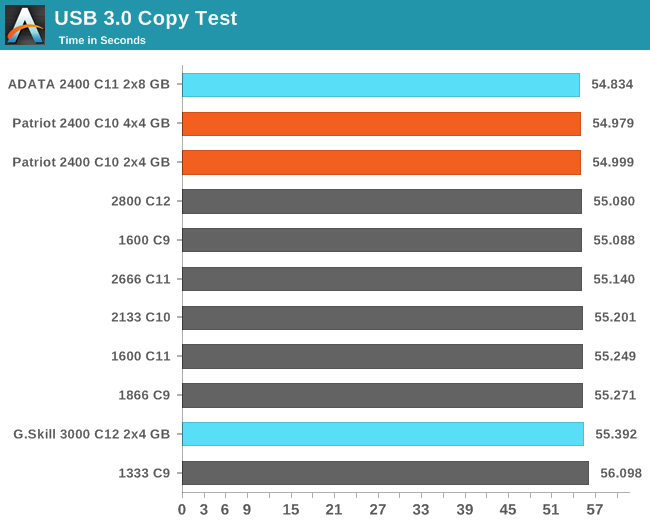
WinRAR 4.2
With 64-bit WinRAR, we compress the set of files used in the USB speed tests. WinRAR x64 3.93 attempts to use multithreading when possible, and provides as a good test for when a system has variable threaded load. WinRAR 4.2 does this a lot better! If a system has multiple speeds to invoke at different loading, the switching between those speeds will determine how well the system will do.
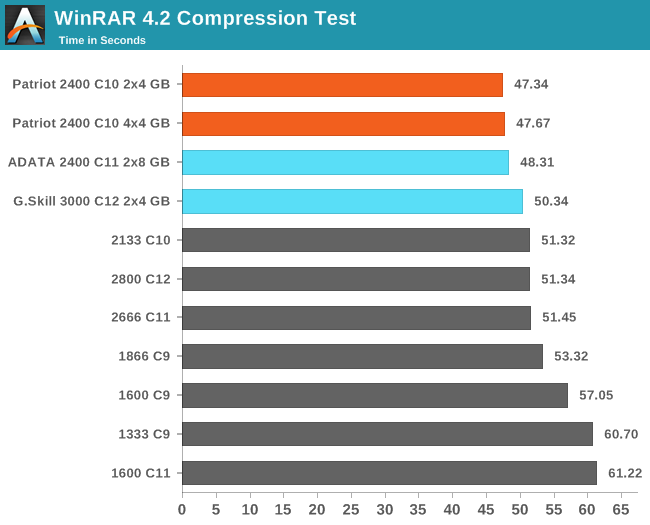
WinRAR is another test we usually see the best memory do well on - the Patriot definitely seems to do the business in our test.
FastStone Image Viewer 4.2
FastStone Image Viewer is a free piece of software I have been using for quite a few years now. It allows quick viewing of flat images, as well as resizing, changing color depth, adding simple text or simple filters. It also has a bulk image conversion tool, which we use here. The software currently operates only in single-thread mode, which should change in later versions of the software. For this test, we convert a series of 170 files, of various resolutions, dimensions and types (of a total size of 163MB), all to the .gif format of 640x480 dimensions. Results shown are in seconds, lower is better.

Xilisoft Video Converter 7
With XVC, users can convert any type of normal video to any compatible format for smartphones, tablets and other devices. By default, it uses all available threads on the system, and in the presence of appropriate graphics cards, can utilize CUDA for NVIDIA GPUs as well as AMD WinAPP for AMD GPUs. For this test, we use a set of 33 HD videos, each lasting 30 seconds, and convert them from 1080p to an iPod H.264 video format using just the CPU. The time taken to convert these videos gives us our result in seconds, where lower is better.

Video Conversion - x264 HD Benchmark
The x264 HD Benchmark uses a common HD encoding tool to process an HD MPEG2 source at 1280x720 at 3963 Kbps. This test represents a standardized result which can be compared across other reviews, and is dependent on both CPU power and memory speed. The benchmark performs a 2-pass encode, and the results shown are the average frame rate of each pass performed four times. Higher is better this time around.
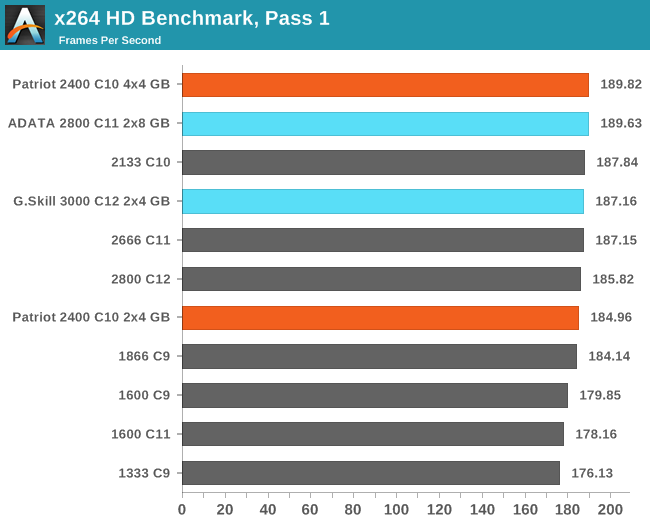
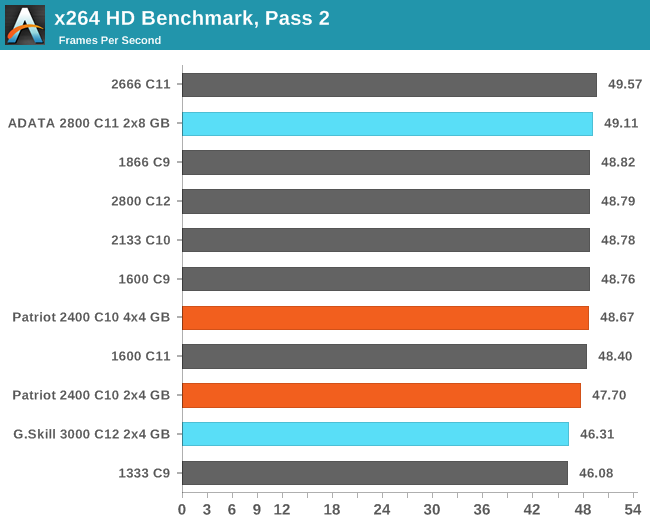
TrueCrypt v7.1a AES
One of Anand’s common CPU benchmarks is TrueCrypt, a tool designed to encrypt data on a hard-drive using a variety of algorithms. We take the program and run the benchmark mode using the fastest AES encryption protocol over a 1GB slice, calculating the speed in GB/s. Higher is better.
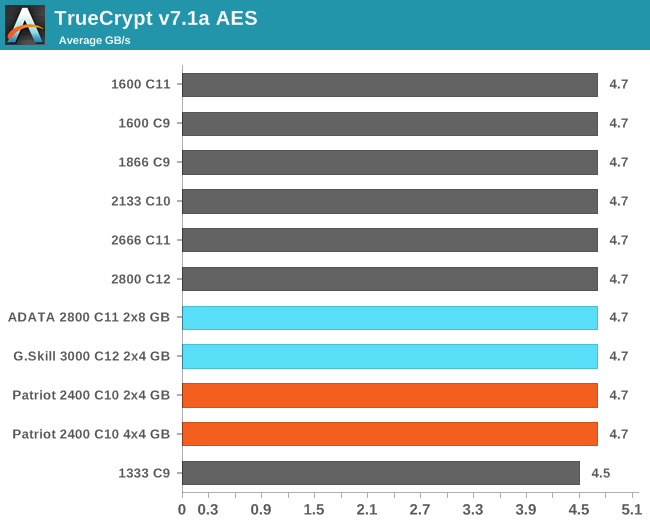










48 Comments
View All Comments
julandorid - Monday, November 18, 2013 - link
Thanks for the review, but what exactly "featured review" means?IanCutress - Monday, November 18, 2013 - link
That's a little tagline we can attach to the front page articles when they're on the top.Wall Street - Monday, November 18, 2013 - link
I think that it is the opposite of capsule review. A featured review is a.k.a. a full review.TemjinGold - Monday, November 18, 2013 - link
Whoa... why is the 2X4 by GSkill $520?IanCutress - Monday, November 18, 2013 - link
DDR-3000 C12: you have to bin a lot of ICs to get ones with the right voltage/performance characteristics for that kit. Same reason why the more expensive CPUs are also the faster (in MHz numbers or cores) than the cheaper ones.ShieTar - Tuesday, November 19, 2013 - link
True. But you can get DDR 2666 with CL10 for about 100€, so a set with an 7% shorter access time (higher "PI" as Ian insists on calling it), and only a 11% lower transfer rate for about a fifth of the price.The 500$ kit seems to be exclusively for those who don't have to work for their money, or maybe those who are hunting records as a hobby.
DanNeely - Tuesday, November 19, 2013 - link
The very top of the line always is extremely expensive, and - when it's the result of extreme binning - has to be in order to limit demand to the miniscule supply available.Gen-An - Tuesday, November 19, 2013 - link
Exactly, they have to test the ICs individually with those tester kits and bin them for speed. I just find it amazing that a chip that is designed for say, 1600 C11 at 1.5v has the potential to run 3100 C12 with 1.65v, that's nearly double its rated clock speed with a mere 0.15v bump in voltage.sf101 - Monday, December 9, 2013 - link
If you want 2400 guaranteed out of the box you pay the premiums.most of the 2133 mhz black momba sticks could also do 2666mhz @ 10-13-10-30-2t but your voltages may vary.
And more than likely some of that is because of individual IMC tolerances per cpu.
Franzen4Real - Monday, November 18, 2013 - link
When it comes to memory, over the years I have tried to read up on different reviews and look at benchmarks in an attempt to understand when it is better to run tighter timings/lower MHz as opposed to looser timings/higher bandwidth. I'm sure it is a case by case basis, but was wondering if the always knowledgeable and helpful Anandtech commenters could give me a quick, dummy terms, explanation of when tight timings or clockspeed is better? Looking at your graph, it shows the C7 1866 through C10 2666 all having the same performance index score, but what situations do those different timings/MHz become better/worse? I hope this isn't too in depth of a question.I don't know if this analogy is correct, but I'm seeing it as if RAM was a race car on a track, high bandwidth/loose timings would mean your car travels faster, but has to do more laps around the track to complete. Tight timings/lower bandwidth means the car travels slower but doesn't have to do as many laps to complete. If I am correct on this, at what point does less laps trump traveling faster?
As a side note, I am looking to build a Haswell desktop in Jan/Feb. It will have one GPU (probably one of the R9's) and more than likely a 2x8gb RAM kit. My usage would very roughly be 70% gaming, 25% rendering in 3DS Max and using some Adobe programs, 5% or less video encoding. I'm looking for help in deciding what to look for in this scenario, but also to finally have a better understanding of how these settings affect different workloads.
Sorry for the wall of text!!